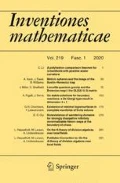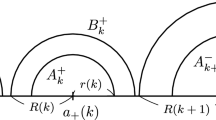Abstract
We show that every sequence of torsion-free arithmetic congruence lattices in \(\mathrm{PGL}(2,{{{\mathbb {R}}}})\) or \(\mathrm{PGL}(2,{{{\mathbb {C}}}})\) satisfies a strong quantitative version of the limit multiplicity property. We deduce that for \(R>0\) in certain range, growing linearly in the degree of the invariant trace field, the volume of the R-thin part of any congruence arithmetic hyperbolic surface or congruence arithmetic hyperbolic 3-manifold M is of order at most \(\mathrm{Vol}(M)^{11/12}\). As an application we prove Gelander’s conjecture on homotopy type of arithmetic hyperbolic 3-manifolds: we show that there are constants A, B such that every such manifold M is homotopy equivalent to a simplicial complex with at most \(A\mathrm{Vol}(M)\) vertices, all of degrees bounded by B.
Similar content being viewed by others
Notes
We used here the fact that \({\mathbf {G}}(k)\) is an adjoint group.
The statement is actually true all regular semisimple elements, but in the torsion case the centralizer might be bigger than what we wrote in the proof.
In the previous version of the manuscript we proved a bound \(\zeta _U^*(7)\le \zeta _k(2)\prod _{\mathfrak {p}\in S\cup \mathrm{Ram}\,_f A}(N(\mathfrak {p})+1)\).
non-torsion just to avoid disconnected centralizers.
The formula is stated there for central simple division algebras but the same statement holds for any reductive algebraic group.
If \(\gamma \) is hyperbolic is it unique, otherwise all eigenvalues are of modulus 1.
i.e. distinct from 1.
If \({{{\mathbb {K}}}}={{{\mathbb {R}}}}\) they are defined over \({{{\mathbb {Q}}}}\) and if \({{{\mathbb {K}}}}={{{\mathbb {C}}}}\) the are defined over a quadratic imaginary number field.
The key feature used for non-uniform lattices is that they are all defined over a quadratic imaginary field. This implies a uniform lower bound on the lengths of closed geodesics on the quotients.
References
Abert, M., Bergeron, N., Biringer, I., Gelander, T., Nikolov, N., Raimbault, J., Samet, I.: On the growth of \(L^2\)-invariants for sequences of lattices in Lie groups. Ann. Math. 185(3), 711–790 (2017)
Arthur, J. (ed.), Harmonic analysis, the trace formula, and shimura varieties. In: Clay Mathematics Proceedings, vol. 4. American Mathematical Society, Providence, RI; Clay Mathematics Institute, Cambridge, MA
Barbasch, D., Moscovici, H.: \(L^{2}\)-index and the Selberg trace formula. J. Funct. Anal. 53(2), 151–201 (1983)
Bardestani, M., Mallahi-Karai, K., Salmasian, H.: Minimal dimension of faithful representations for \(p\)-groups. J. Group Theory 19(4), 589–608 (2016)
Benjamini, I., Schramm, O.: Recurrence of distributional limits of finite planar graphs. Electron. J. Probab. 6(23), 13 (2001) (electronic)
Bergeron, N., Clozel, L.: Spectre automorphe des variétés hyperboliques et applications topologiques, Société mathématique de France (2005)
Bilu, Y.: Limit distribution of small points on algebraic tori. Duke Math. J. 89(3), 465–476 (1997)
Borel, A.: Commensurability classes and volumes of hyperbolic 3-manifolds. Ann. Scuola Norm. Sup. Pisa Cl. Sci. (4) 8(1), 1–33 (1981)
Borel, A., Wallach, N.: Continuous Cohomology, Discrete Subgroups, and Representations of Reductive Groups, Second, Mathematical Surveys and Monographs, vol. 67. American Mathematical Society, Providence (2000)
Bott, R., Tu, L.W.: Differential Forms in Algebraic Topology, Graduate Texts in Mathematics, vol. 82. Springer, New York (1982)
Carayol, H.: Représentations cuspidales du groupe linéaire. Ann. Sci. École Norm. Sup. (4) 17(2), 191–225 (1984)
Chinburg, T., Friedman, E.: The smallest arithmetic hyperbolic three-orbifold. Invent. Math. 86(3), 507–527 (1986)
Clozel, L.: On limit multiplicities of discrete series representations in spaces of automorphic forms. Invent. Math. 83(2), 265–284 (1986)
de George, D.L., Wallach, N.R.: Limit formulas for multiplicities in \(L^{2}({\varGamma } \backslash G)\). Ann. Math. (2) 107(1), 133–150 (1978)
DeGeorge, D.L., Wallach, N.R.: Limit formulas for multiplicities in \(L^{2}({\varGamma } \backslash G)\). II. The tempered spectrum. Ann. Math. (2) 109(3), 477–495 (1979)
DeGeorge, D.L.: On a theorem of Osborne and Warner. Multiplicities in the cuspidal spectrum. J. Funct. Anal. 48(1), 81–94 (1982)
Delorme, P.: Formules limites et formules asymptotiques pour les multiplicités dans \({L}^2(g/\gamma )\). Duke Math. J. 53(3), 691–731 (1986). (French)
Dixmier, J.: \({C}^*\)-algebras, North-Holland Publishing Co., Amsterdam-New York-Oxford. Translated from the French by Francis Jellett; North-Holland Mathematical Library, Vol. 15
Dobrowolski, E.: On a question of Lehmer and the number of irreducible factors of a polynomial. Acta Arith. 34(4), 391–401 (1979)
Finis, T.: The limit multiplicity problem for congruence subgroups of arithmetic lattices and the trace formula. Kyoto Proc. 2013, 164–176 (1871)
Finis, T., Lapid, E.: An approximation principle for congruence subgroups. J. Eur. Math. Soc. (JEMS) 20(5), 1075–1138 (2018)
Finis, T., Lapid, E.: An approximation principle for congruence subgroups II: application to the limit multiplicity problem. Math. Z. 289(3–4), 1357–1380 (2018)
Finis, T., Lapid, E., Müller, W.: Limit multiplicities for principal congruence subgroups of \({\rm GL}(n)\) and \({\rm SL}(n)\). J. Inst. Math. Jussieu 14(3), 589–638 (2015)
Friedman, E.: Analytic formulas for the regulator of a number field. Invent. Math. 98(3), 599–622 (1989)
Frączyk, M., Raimbault, J.: Betti numbers of Shimura curves and arithmetic three-orbifolds. Algebra Number Theory 13(10), 2359–2382 (2019)
Gelander, T.: Homotopy type and volume of locally symmetric manifolds. Duke Math. J. 124(3), 459–515 (2004)
Häsä, J., Stasinski, A.: Representation growth of compact linear groups. Trans. Am. Math. Soc. 372(2), 925–980 (2019)
Labesse, J.-P., Langlands, R.P.: \(L\)-indistinguishability for \({\rm SL}(2)\). Can. J. Math. 31(4), 726–785 (1979)
Lang, S.: Algebraic Number Theory, 2nd edn. Graduate Texts in Mathematics, vol. 110. Springer, New York
Lang, S.: \({\rm SL}_2({\bf R})\), Graduate Texts in Mathematics, vol. 105. Springer, New York (1985). Reprint of the 1975 edition
Langlands, R.P.: Base Change for GL(2), Annals of Mathematics Studies, vol. 96. Princeton University Press, Princeton; University of Tokyo Press, Tokyo (1980)
Larsen, M.: http://mlarsen.math.indiana.edu (2008)
Levit, A.: On Benjamini–Schramm limits of congruence subgroups (2017). arXiv:1705.04200
Linowitz, B., McReynolds, D.B., Pollack, P., Thompson, L.: Bounded gaps between primes and the length spectra of arithmetic hyperbolic 3-orbifolds. C. R. Math. Acad. Sci. Paris 355(11), 1121–1126 (2017)
Linowitz, B., McReynolds, D.B., Pollack, P., Thompson, L.: Systoles of arithmetic hyperbolic surfaces and 3-manifolds. Math. Res. Lett. 24(5), 1497–1522 (2017)
Linowitz, B., McReynolds, D.B., Pollack, P., Thompson, L.: Counting and effective rigidity in algebra and geometry. Invent. Math. 213(2), 697–758 (2018)
Matsushima, Y., et al.: A formula for the betti numbers of compact locally symmetric Riemannian manifolds. J. Differ. Geom. 1(1–2), 99–109 (1967)
Matz, J.: Limit multiplicities for \({\rm SL}_2({\cal{O}}_F)\) in \({\rm SL}_2({\mathbb{R}}^{r_1}\oplus {\mathbb{C}}^{r_2})\). Groups Geom. Dyn. 13(3), 841–881 (2019)
Milne, J.S.: Class Field Theory, lecture notes available at www.math.lsa.umich.edu (1997)
Nelson, P.D., Venkatesh, A.: The orbit method and analysis of automorphic forms. arXiv preprint arXiv:1805.07750 (2018)
Odlyzko, A.M.: Lower bounds for discriminants of number fields. II. Tôhoku Math. J. 29(2), 209–216 (1977)
Ono, T.: Arithmetic of algebraic tori. Ann. Math. (2) 74, 101–139 (1961)
Ono, T.: On the Tamagawa number of algebraic tori. Ann. Math. (2) 78, 47–73 (1963)
Platonov, V., Rapinchuk, A.: Algebraic groups and number theory. Pure and Applied Mathematics, vol. 139. Academic Press, Inc., Boston, MA. Translated from the 1991 Russian original by Rachel Rowen
Raimbault, J.: On the convergence of arithmetic orbifolds. Ann. Inst. Fourier (Grenoble) 67(6), 2547–2596 (2017)
Ratcliffe, J.: Foundations of Hyperbolic Manifolds, Graduate Texts in Mathematics. Springer, New York (2006)
Reid, A., MacLachlan, C.: The Arithmetic of Hyperbolic 3-Manifolds, Graduate Texts in Mathematics, vol. 219. Springer, New York (2003)
Rohlfs, J., Speh, B.: On limit multiplicities of representations with cohomology in the cuspidal spectrum. Duke Math. J. 55(1), 199–211 (1987)
Sarnak, P.C.: A note on the spectrum of cusp forms for congruence subgroups. Preprint (1982)
Sauvageot, F.: Principe de densité pour les groupes réductifs. Compositio Math. 108(2), 151–184 (1997) (French, with English and French summaries)
Savin, G.: Limit multiplicities of cusp forms. Invent. Math. 95(1), 149–159 (1989)
Serre, J.-P.: Une "formule de masse" pour les extensions totalement ramifiées de degré donné d’un corps local. C. R. Acad. Sci. Paris Sér. A-B 286(22), A1031–A1036 (1978)
Shalom, Y.: Rigidity, unitary representations of semisimple groups, and fundamental groups of manifolds with rank one transformation group. Ann. Math. (2) 152(1), 113–182 (2000)
Shyr, J.-M.: Class number formula of algebraic tori with applications to relative class numbers of certain relative quadratic extensions of algebraic number fields. Ph.D. Thesis. Thesis (Ph.D.)—The Johns Hopkins University
Silberger, A.J.: \({\rm PGL}_{2}\) over the \(p\)-adics: its representations, spherical functions, and Fourier analysis, Lecture Notes in Mathematics, vol. 166. Springer, Berlin (1970)
Silberger, A.J.: Irreducible representations of a maximal compact subgroup of \({\rm PGL}_{2}\) over the \(p\)-adics. Math. Ann. 229(1), 1–12 (1977)
Ullmo, E., Yafaev, A.: Nombre de classes des tores de multiplication complexe et bornes inférieures pour les orbites galoisiennes de points spéciaux. Bull. Soc. Math. France 143(1), 197–228 (2015)
Zimmer, R.J.: Ergodic Theory and Semisimple Groups, vol. 81. Springer, Berlin (2013)
Zimmert, R.: Ideale kleiner Norm in Idealklassen und eine Regulatorabschätzung. Invent. Math. 62(3), 367–380 (1981)
Acknowledgements
This began as a part of author’s PhD thesis at the Université Paris-Sud. I would like to thank my supervisor Emmanuel Breuillard for suggesting this problem as well as for many useful remarks. I am grateful to Nicolas Bergeron and Erez Lapid for careful reading the first version of the manuscript. I acknowledge the support of ERC Consolidator Grant No. 648017 during the last stages of work. I am thankful to the Institute for Advanced Study for providing excellent working conditions when I wrote the current version of the manuscpript. Finally I thank anonymous referees whose valuable remarks and suggestions led to a much improved exposition and improvement of results.
Author information
Authors and Affiliations
Corresponding author
Additional information
Publisher's Note
Springer Nature remains neutral with regard to jurisdictional claims in published maps and institutional affiliations.
This work was supported by a public grant as part of the Investissement d’avenir project, reference ANR-11-LABX-0056-LMH, LabEx mathématique Hadamard and by ERC Consolidator Grant No. 648017.
Rights and permissions
About this article
Cite this article
Frączyk, M. Strong limit multiplicity for arithmetic hyperbolic surfaces and 3-manifolds. Invent. math. 224, 917–985 (2021). https://doi.org/10.1007/s00222-020-01021-1
Received:
Accepted:
Published:
Issue Date:
DOI: https://doi.org/10.1007/s00222-020-01021-1



